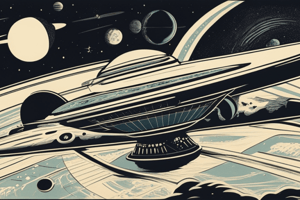Podcast
Questions and Answers
ما هو الكوكب الذي يُعرف بنظام الحلقات البارز لديه؟
ما هو الكوكب الذي يُعرف بنظام الحلقات البارز لديه؟
ما هو الكوكب المائل على محوره مما يُسبب فصولًا متطرفة؟
ما هو الكوكب المائل على محوره مما يُسبب فصولًا متطرفة؟
ما هو الجسم الذي يُعرف بلونه الأزرق العميق والطقس العنيف؟
ما هو الجسم الذي يُعرف بلونه الأزرق العميق والطقس العنيف؟
ما هي الأجرام الصخرية التي تدور حول الشمس بين مداري المريخ وزحل؟
ما هي الأجرام الصخرية التي تدور حول الشمس بين مداري المريخ وزحل؟
ما هي الأجسام الجليدية التي تنبثق من النظام الشمسي الخارجي وتتبخر عند اقترابها من الشمس؟
ما هي الأجسام الجليدية التي تنبثق من النظام الشمسي الخارجي وتتبخر عند اقترابها من الشمس؟
Flashcards are hidden until you start studying
Study Notes
The Solar System
The Solar System, known in Arabic as "المجموعة الشمسية", is a vast collection of celestial objects that revolve around the Sun, which is the center of the system. The Solar System consists of eight planets, including the Sun and various other objects, such as moons, asteroids, and comets.
Planets
The eight planets in the Solar System, in order from the Sun, are:
-
Mercury: The smallest planet, Mercury, is the closest planet to the Sun. It is a rocky, volcanic planet with a thin atmosphere and a very hot surface.
-
Venus: The second planet from the Sun, Venus, is similar in size to Earth and is known as Earth's "sister planet". It is the hottest planet in the Solar System, with thick clouds of sulfuric acid.
-
Earth: The third planet from the Sun, Earth, is the only planet not named after a Greek or Roman god. It is the only known planet to harbor life and has a diverse array of ecosystems.
-
Mars: The fourth planet from the Sun, Mars, is known as the "Red Planet" due to its reddish appearance. It is a rocky, dry planet with a thin atmosphere and the largest volcano in the Solar System, Olympus Mons.
-
Jupiter: The fifth planet from the Sun, Jupiter, is the largest planet in the Solar System. It is a gas giant, with a thick atmosphere and a swirling storm known as the Great Red Spot.
-
Saturn: The sixth planet from the Sun, Saturn, is also a gas giant. It is known for its prominent ring system, which is composed of ice particles and rock.
-
Uranus: The seventh planet from the Sun, Uranus, is an ice giant. It is tilted on its axis, which causes extreme seasons.
-
Neptune: The eighth and farthest planet from the Sun, Neptune, is also an ice giant. It is known for its deep blue color and violent weather.
Other Objects
In addition to the eight planets, the Solar System also contains various other objects:
-
The Sun: The center of the Solar System, the Sun is a star that provides light and heat to the planets.
-
Moons: Each planet has several moons, with the largest being Titan, a moon of Saturn.
-
Asteroids: These are rocky objects that orbit the Sun between the orbits of Mars and Jupiter.
-
Comets: These are icy objects that originate from the outer Solar System. When they come close to the Sun, they vaporize and create a glowing coma.
The Solar System is a fascinating and diverse collection of celestial objects, each with its own unique characteristics and features. Understanding this system and its components helps us to better appreciate the vastness and complexity of our universe.
Studying That Suits You
Use AI to generate personalized quizzes and flashcards to suit your learning preferences.




